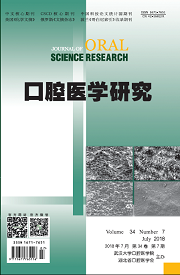|
|
Expression of Aquaporin 5 and Programmed Cell Death 5 in Rat Parotid Gland after Ligation and Recanalization
TANG Xue-min, SUN Chang-hua, ZHU Yu-hong, WANG Jing , YANG Yong, DING Chang-ling, ZUO Jin-hua
2018, 34(7):
774-779.
DOI: 10.13701/j.cnki.kqyxyj.2018.07.022
Objective: To investigate the regenerating ability of parotid gland after different ligated time, and the effect of aquaporin 5 (AQP5) and programmed cell death 5 (PDCD5) on the regeneration of parotid gland in rats. Methods: The parotid gland was ligated and then reopened after 7 days (group A),14 days (group B),and 21 days (group C),respectively.The samples were obtained at different time points (0,1,3,5,7,10,14,21, and 28 days). The morphological changes of glandular tissue were observed by HE staining, and the expression patterns of AQP5 and PDCD5 in acinor cells and glandular cells were explored. Results: Gland regeneration occurred in three groups after the reopen of main duct of parotid gland. The expression of AQP5 could increase to the normal level after reopen 14 days and 21 days for group A and group B, however, not recover to the normal level even after 28 days for group C. Expression of PDCD5 increased with the increase of apoptosis of the duct after the gland release. The three groups reached the highest level respectively after the recanalization of fifth days, the tenth day, and the fourteenth day, the peak value of group B was the highest, group C was the second, and the peak value of group A was the lowest. Conclusions: The longer the time ligation of the main duct of rat parotid gland, the worse the ability of regeneration. The expression of AQP5 is an important marker of functional recovers of the gland. Apoptosis of ductal like structure happened during the gland regeneration.
References |
Related Articles |
Metrics
|

